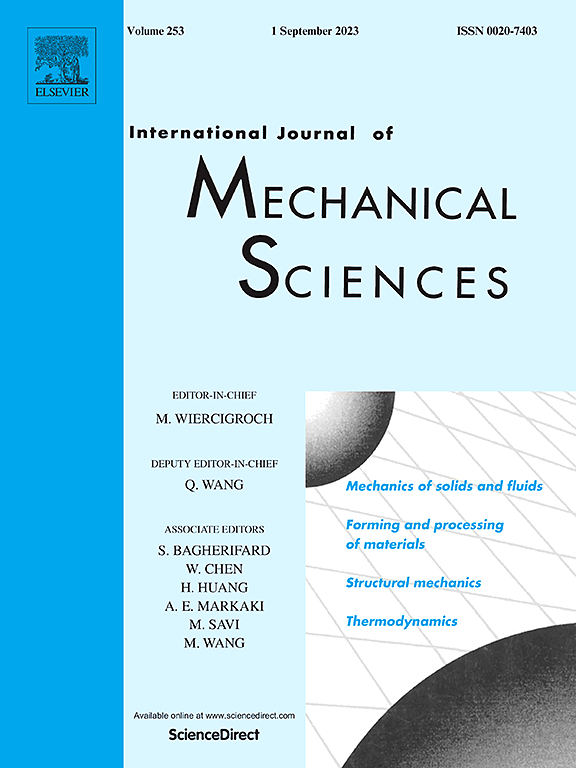A displacement equipartition structure assisted self-friction metamaterial for energy dissipation
IF 7.1
1区 工程技术
Q1 ENGINEERING, MECHANICAL
International Journal of Mechanical Sciences
Pub Date : 2025-07-20
DOI:10.1016/j.ijmecsci.2025.110627
引用次数: 0
Abstract
To address the issues of low energy dissipation efficiency and significant force fluctuation in traditional series-connected negative stiffness metamaterials (NSMs), this study proposes a displacement equalization structure (DES) assisted self-friction metamaterial (DES-SFM). The DES-SFM employs an external bow-shaped frame to provide monostable restoring force. Its core energy dissipation mechanism, inspired by backpack buckles, consists of a friction system formed by vertical clamping beams with trapezoidal protrusions and horizontal cantilever beams, which synchronously exhibit negative stiffness behavior during snap-through events. The DES enables multi-level displacement equalization through geometric constraints provided by a rhombus linkage mechanism. The performance of the DES-SFM is validated via theoretical modeling, numerical simulations, and experimental tests. Results demonstrate that the energy dissipation efficiency of DES-SFM reaches 65.5%, and it exhibits excellent reusability. Adjusting the geometric parameters can further enhance the energy dissipation capacity. Moreover, it effectively reduces impact response time, achieving a maximum peak acceleration reduction of up to 95.8%. In the six-stage series configuration, the DES demonstrates a fluctuation suppression rate of 90%. The proposed DES-SFM provides a new solution for reusable buffering applications, while its DES design offers insights into load balancing in series-connected metamaterial systems.一种位移均分结构辅助能量耗散的自摩擦材料
针对传统串联负刚度超材料(nsm)耗能效率低、力波动大的问题,提出了一种位移均衡结构(DES)辅助自摩擦超材料(DES- sfm)。DES-SFM采用外部弓形框架提供单稳态恢复力。其核心能量耗散机制的灵感来自背包扣,由具有梯形突起的垂直夹紧梁和水平悬臂梁组成的摩擦系统组成,在弹穿事件中同步表现出负刚度行为。DES通过菱形连杆机构提供的几何约束实现多级位移均衡。通过理论建模、数值模拟和实验测试验证了DES-SFM的性能。结果表明,DES-SFM耗能效率达到65.5%,具有良好的可重复使用性。调整几何参数可以进一步提高消能能力。此外,它有效地缩短了冲击响应时间,最大峰值加速度降低高达95.8%。在6级串联配置中,DES的波动抑制率为90%。提出的DES- sfm为可重用缓冲应用提供了一种新的解决方案,而其DES设计为串联超材料系统的负载平衡提供了见解。
本文章由计算机程序翻译,如有差异,请以英文原文为准。
求助全文
约1分钟内获得全文
求助全文
来源期刊

International Journal of Mechanical Sciences
工程技术-工程:机械
CiteScore
12.80
自引率
17.80%
发文量
769
审稿时长
19 days
期刊介绍:
The International Journal of Mechanical Sciences (IJMS) serves as a global platform for the publication and dissemination of original research that contributes to a deeper scientific understanding of the fundamental disciplines within mechanical, civil, and material engineering.
The primary focus of IJMS is to showcase innovative and ground-breaking work that utilizes analytical and computational modeling techniques, such as Finite Element Method (FEM), Boundary Element Method (BEM), and mesh-free methods, among others. These modeling methods are applied to diverse fields including rigid-body mechanics (e.g., dynamics, vibration, stability), structural mechanics, metal forming, advanced materials (e.g., metals, composites, cellular, smart) behavior and applications, impact mechanics, strain localization, and other nonlinear effects (e.g., large deflections, plasticity, fracture).
Additionally, IJMS covers the realms of fluid mechanics (both external and internal flows), tribology, thermodynamics, and materials processing. These subjects collectively form the core of the journal's content.
In summary, IJMS provides a prestigious platform for researchers to present their original contributions, shedding light on analytical and computational modeling methods in various areas of mechanical engineering, as well as exploring the behavior and application of advanced materials, fluid mechanics, thermodynamics, and materials processing.
 求助内容:
求助内容: 应助结果提醒方式:
应助结果提醒方式:


